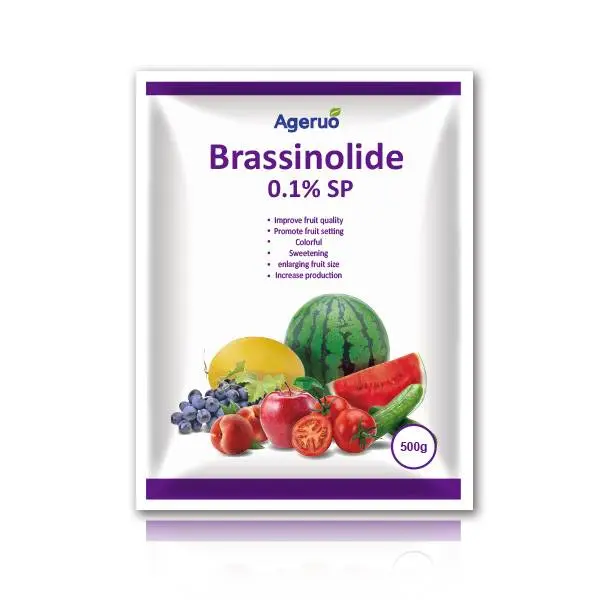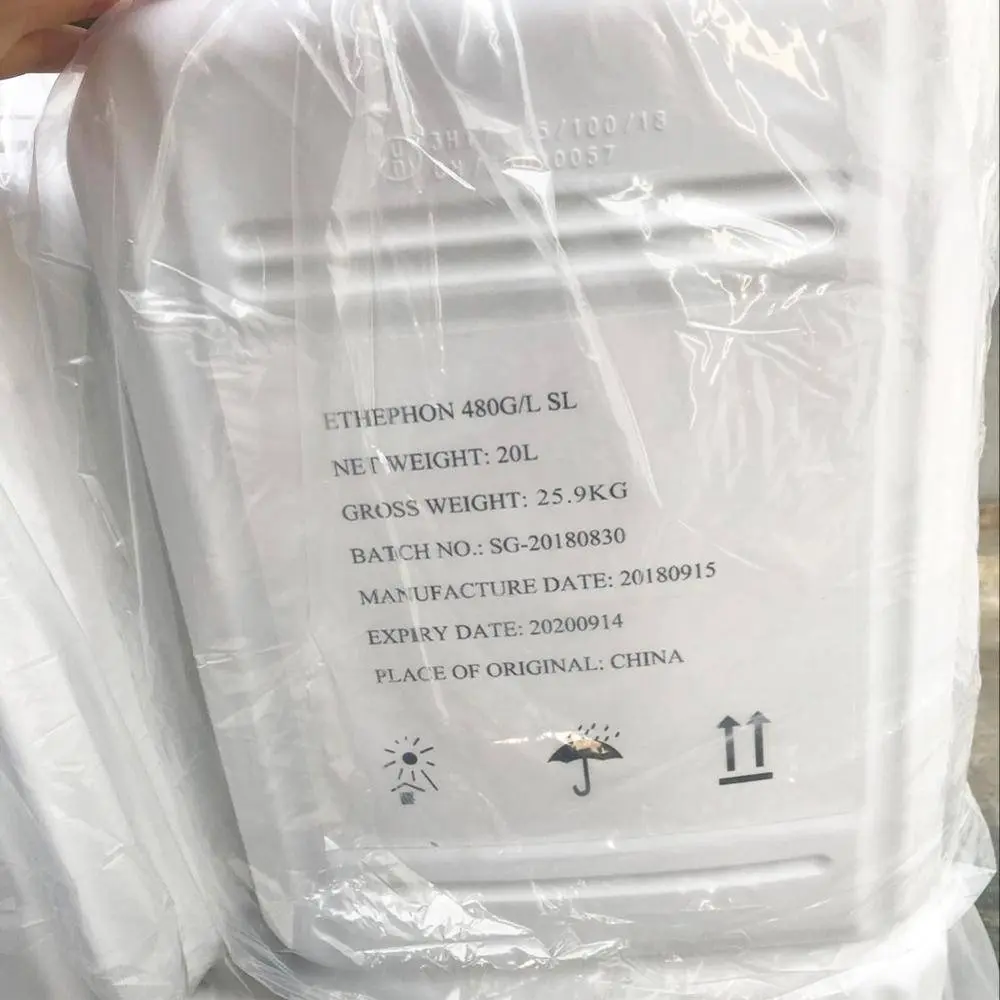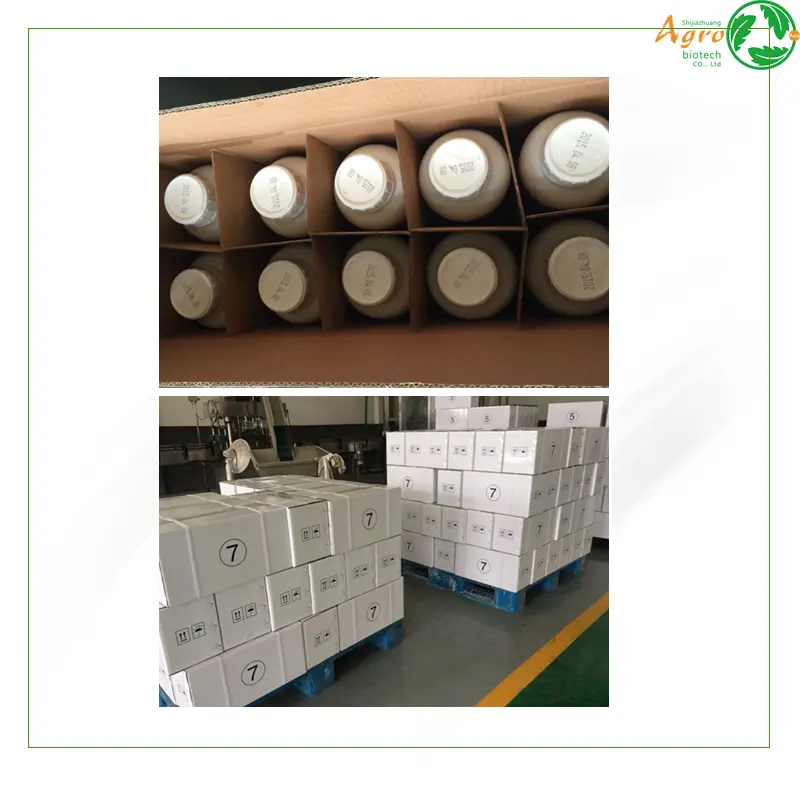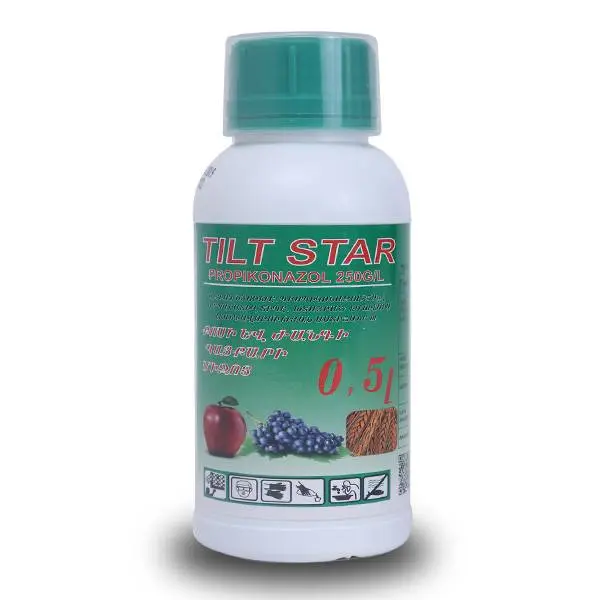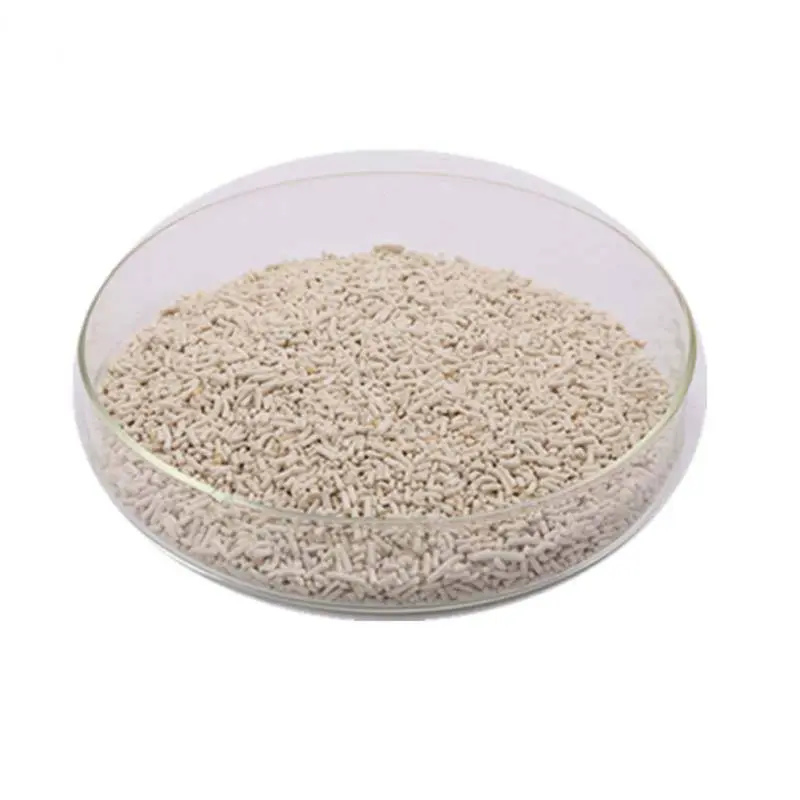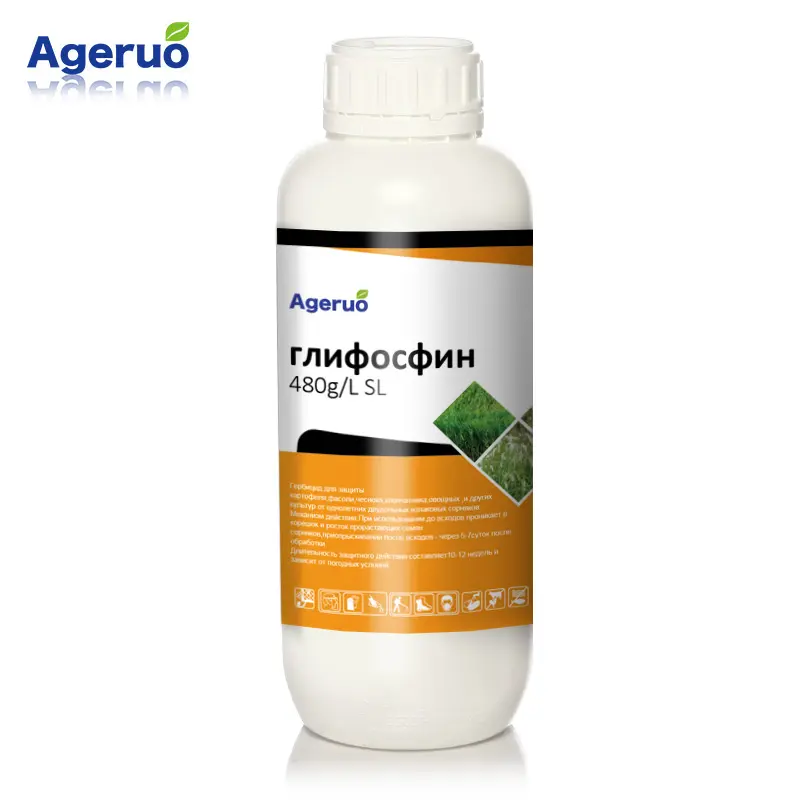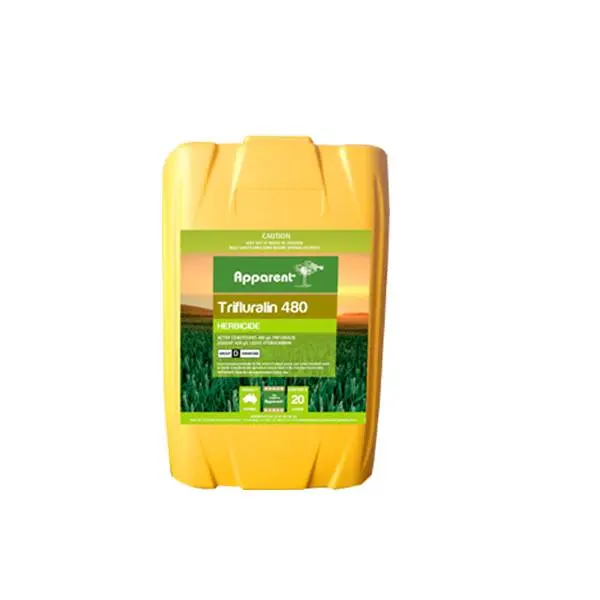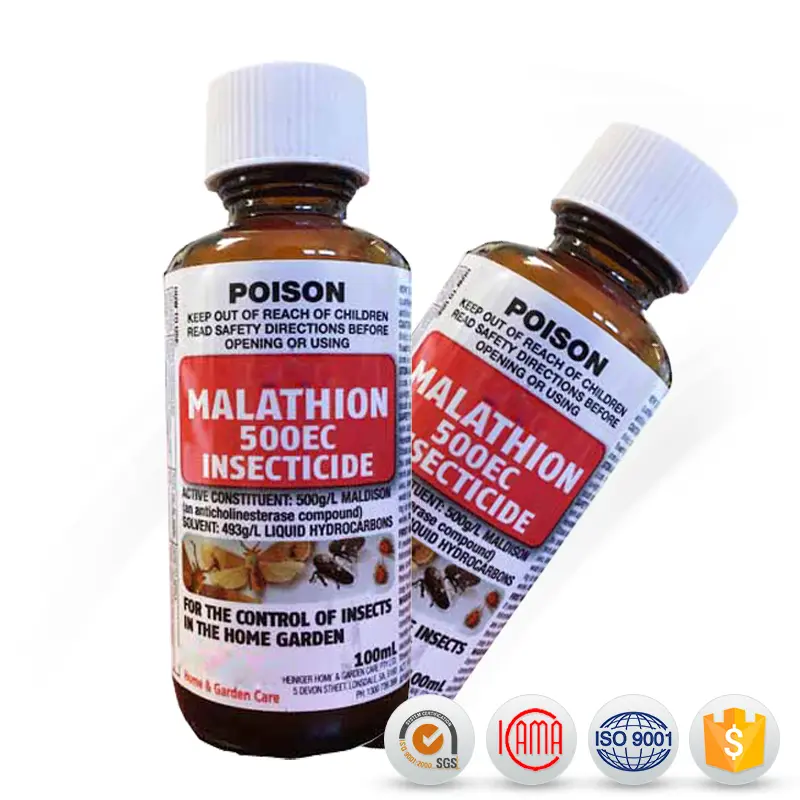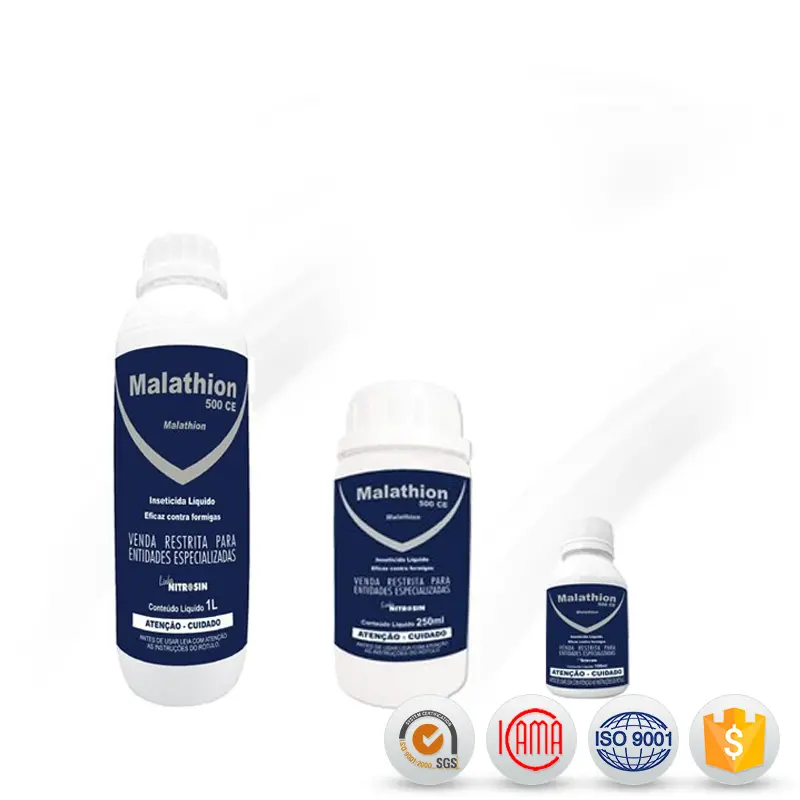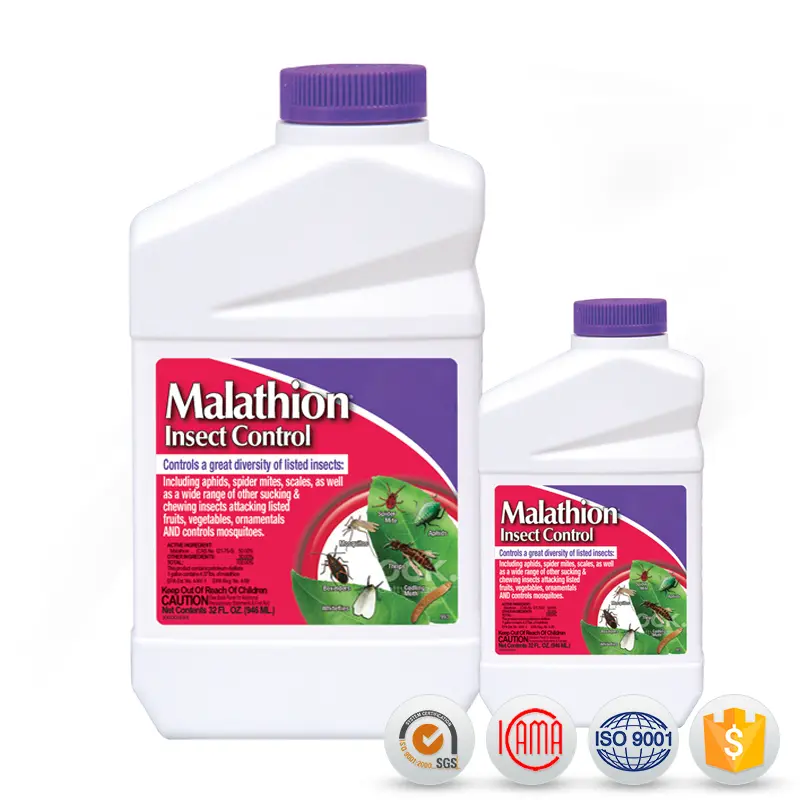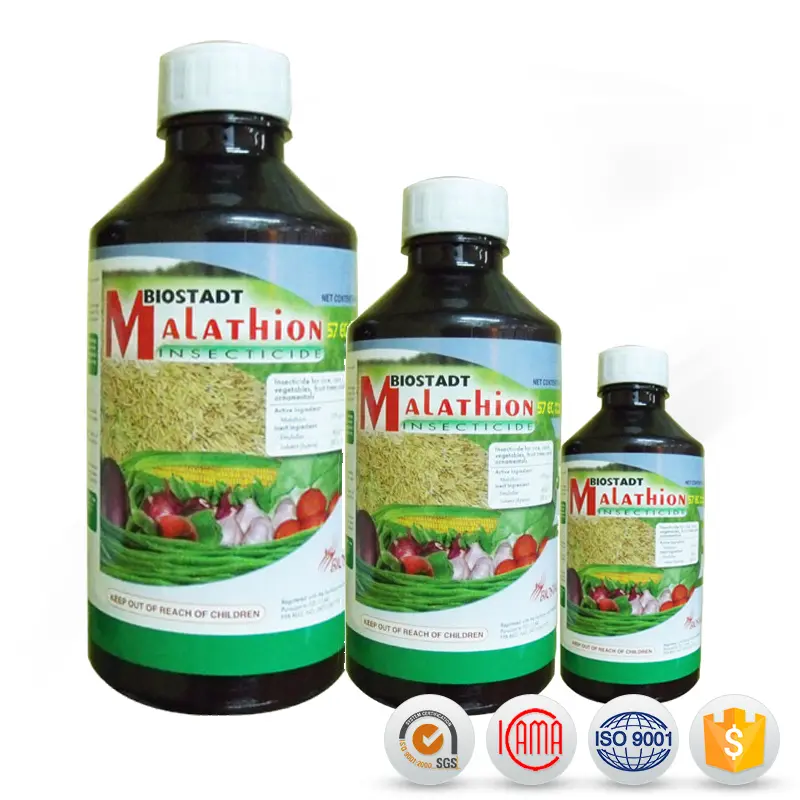- Fungicide
-
Herbicide
- 2,4-D Amine
- Atrazine
- Carfentrazone-ethyl
- Clethodim
- Cyhalofop-butyl
- Diquat
- Diuron
- Glufosinate-ammonium
- Glyphosate
- Haloxyfop-r-methyl
- Linuron
- Metribuzin
- Nicosulfuron
- Oxyfluorfen
- Paraquat
- Pendimethalin
- Penoxsulam
- pinoxaden
- Quinclorac
- Quizalofop-p-ethyl
- Rimsulfuron
- Sodium Nitrophenolate
- Thifensulfuron Methyl
- Tribenuron-methyl
- Trifloxysulfuron
- Trifluralin
-
Insecticide
- Abamectin
- Acetamiprid
- Alpha cypermethrin
- Amitraz
- Bifenazate
- Bifenthrin
- Cartap
- Chlorfenapyr
- Chlorpyrifos
- Cyromazine
- Deltamethrin
- Diflubenzuron
- Dimethoate
- Dinotefuran
- Emamectin benzoate
- Fenthion
- Fipronil
- Flonicamid
- Imidacloprid
- Indoxacarb
- Lambda cyhalothrin
- Lufenuron
- Malathion
- Matrine
- Metaldehyde
- Methomyl
- Profenofos
- Pyridaben
- Spirodiclofen
- Thiamethoxam
- Thiocyclam
- Plant Growth Regulator
- Complex Formula
- Seed-Dressing Agent
- Fertilizer additive
- New Products
Pesticides chemical Malathion 90%TC capstar nitenpyram Mala
product detail
How Malathion Works – Fast-Acting, Contact and Stomach Poison with Broad-Spectrum Control
Malathion is a non-systemic organophosphorus insecticide that acts primarily through contact and ingestion. Once absorbed by the insect, it disrupts the normal function of their nervous system, causing rapid paralysis and death within hours. It is especially effective against soft-bodied insects and mites in both open-field and greenhouse settings.
Key Features and Mode of Action
-
Nerve Poison: Inhibits acetylcholinesterase enzyme in insects, resulting in nervous system failure.
-
Fast Paralysis: Insects stop feeding shortly after exposure and die within 3–4 days.
-
Contact and Ingestion: Works both on external contact and when ingested through treated plant surfaces.
-
No Residual Systemic Movement: This helps reduce residue risks in food crops.
Benefits for Your Customers
-
Effective Against a Broad Range of Pests, including aphids, leaf-rollers, thrips, lygus bugs, and mites.
-
Versatile Crop Application: Used in cotton, rice, wheat, vegetables, and orchard crops.
-
Flexible Formulations: Can be used alone or combined with other insecticides in EC or EW formulations.
-
Cost-Effective Solution: Offers high performance with low application cost per hectare.
Malathion remains one of the most trusted choices globally for integrated pest control programs, particularly where resistance management and public health safety are priorities.
Formulation Flexibility and Practical Field Recommendations
At POMAIS, we offer Malathion in multiple formulation types to meet the needs of various markets, including both technical material for repacking or blending, and ready-to-use liquid formulations for direct field application.
Available Formulations
Technical Grade:
-
Malathion 90% TC
-
Malathion 95% TC
Supplied in sealed iron drums or composite containers for industrial formulation.
Liquid Formulations (for agricultural use):
-
1.8% EC, 2% EC, 3.6% EC, 5.4% EC
-
1.8% EW, 3.6% EW
We support:
-
Private formula customization
-
Solvent and emulsifier adjustment based on country-specific climate, regulation, and crop systems
Application Recommendations
The following table summarizes field-tested dosage rates for major crops and target pests using Malathion EC formulations:
| Formulation | Crop | Target Pest | Recommended Dosage |
|---|---|---|---|
| Malathion 57% EC | Cotton | Lygus lucorum (mirid bug) | 506.3–607.5 g/ha |
| Malathion 57% EC | Wheat | Aphids | 540–742.5 g/ha |
| Malathion 57% EC | Rice | Leaf-rollers | 675–810 g/ha |
For other crops such as vegetables, tea, or fruit trees, dilution rates and frequency can be adjusted. Use in accordance with local label or agronomic guidelines.
Application Methods
-
Foliar spray: Standard high-pressure or low-volume sprayers
-
Dilution: Typically with 200–500 liters of water per hectare depending on crop density
-
Interval: Repeat every 7–10 days if necessary; observe local pre-harvest interval (PHI)
Always apply during early morning or late afternoon to reduce evaporation and maximize leaf retention.
Broad-Spectrum Pest Control Across Key Agricultural Crops
Malathion is widely recognized for its ability to control a broad range of chewing and sucking insects, making it an essential insecticide in integrated pest management (IPM) programs across different climates and farming systems.
1. Main Crops Treated
Malathion is effective in the protection of:
-
Cereals:
-
Wheat
-
Rice
-
Maize
-
-
Industrial crops:
-
Cotton
-
Sugarcane
-
Tobacco
-
-
Horticultural crops:
-
Cabbage, tomato, eggplant, onion
-
Citrus, apple, grape, mango
-
Tea, coffee
-
-
Oilseed and legumes:
-
Soybean
-
Groundnut
-
Peas and lentils
-
2. Target Pest Spectrum
Malathion is highly effective against the following pests:
| Pest Type | Common Names | Mode of Action |
|---|---|---|
| Sucking pests | Aphids, leafhoppers, thrips, whiteflies | Contact + Stomach |
| Chewing pests | Leaf-rollers, caterpillars, grasshoppers | Contact + Ingestion |
| Piercing-sucking pests | Mirid bugs (Lygus lucorum), stink bugs | Neurological disruption |
| Storage pests | Grain weevils, flour beetles | Residual surface control |
Malathion's broad activity and quick knockdown make it a go-to solution for mixed pest pressure, especially in early-season crop protection or in areas facing resistance to newer actives.
3. Special Applications
-
Post-harvest insect control:
Used to treat stored grains and storage facilities -
Public health use (non-agricultural):
Sometimes used in vector control programs (e.g., mosquitoes) under specific guidelines
Malathion’s performance in diverse climates and cropping systems allows distributors to position it as a core solution in IPM-based sales programs, or as a cost-effective broad-spectrum control option in price-sensitive markets.
How Malathion Works – Nerve Agent Mode of Action for Rapid Pest Knockdown
Malathion is a classic organophosphorus insecticide that functions as an acetylcholinesterase (AChE) inhibitor. It interrupts the nerve signal transmission in insects, resulting in paralysis and death shortly after exposure. Its dual mode of action—via contact and ingestion—makes it highly effective even under varied pest pressures.
1. Inhibits Acetylcholinesterase in Insects
-
Malathion binds to the enzyme acetylcholinesterase, which insects need to break down acetylcholine, a key neurotransmitter.
-
When this enzyme is inhibited:
-
Acetylcholine accumulates
-
Insect nerves remain constantly stimulated
-
This leads to uncontrolled nerve impulses, causing paralysis and eventual death
-
This biochemical disruption occurs within hours, making Malathion an ideal choice for quick control during pest outbreaks.
2. Dual Action: Contact and Stomach Poison
-
Contact Action:
Insects are affected when they come into contact with sprayed surfaces—ideal for leaf surfaces and pest resting zones. -
Ingestion Action:
When pests feed on treated plant tissues, the poison enters their system through the gut.
Together, this provides both external protection and internal kill, offering flexibility in pest management across crops and pest types.
3. Not Systemic – Surface Action with Low Residue Risks
-
Malathion does not penetrate deep into plant tissues, making it suitable for:
-
Crops with short pre-harvest intervals
-
Export produce markets concerned about maximum residue limits (MRLs)
-
Its non-systemic behavior reduces concerns about movement into fruits or grains.
4. Role in Resistance Management
-
Malathion has a different mode of action than modern neonicotinoids, pyrethroids, or diamides.
-
It is often used:
-
In rotation programs to manage resistance
-
As a mixing partner in tank blends to broaden pest control spectrum
-
In markets where resistance to newer insecticides is emerging, Malathion remains a reliable and economical alternative.
Application Guidelines – Simple, Effective, and Field-Proven
Malathion is suitable for a wide range of spraying programs in row crops, orchards, and vegetables. Whether used alone or in a tank mix, proper application ensures quick knockdown, lasting control, and residue safety. Below is a structured guide to help you or your clients apply Malathion effectively.
1. Recommended Timing
-
Apply at early pest appearance, especially during early vegetative or pre-flowering stages.
-
Repeat applications can be done every 7–10 days based on pest pressure and local conditions.
-
For storage pest treatment or seed warehouse use, follow surface treatment guidelines specific to non-food areas.
2. Application Methods
-
Foliar Spray: Standard knapsack or boom sprayers; suitable for field crops, vegetables, and orchards.
-
Broadcast Spray: For large-area cereal crops like rice and wheat.
-
Spot Treatment: In nurseries or greenhouses where localized outbreaks occur.
-
Seed/Grain Storage: Apply as a surface residual spray to clean storage bins or sacks.
3. Spray Volume and Dilution
| Formulation | Water Volume per ha | Dilution Ratio |
|---|---|---|
| 57% EC | 200–500 L/ha | ~500–700 times dilution depending on crop |
| 1.8–5.4% EC | 200–400 L/ha | Adjust volume based on pest density |
Always agitate the solution before and during spraying for uniform coverage. Use fine nozzles for leaf and flower canopy applications.
4. Safety Intervals
-
Re-entry period (REI): 12–24 hours after spraying.
-
Pre-harvest interval (PHI):
-
7 days for vegetables
-
10–14 days for cereals or cotton
(Always confirm with local label recommendations)
-
5. Application Precautions
-
Avoid spraying during midday sun, strong wind, or rain within 2 hours.
-
Always use PPE: gloves, masks, long sleeves, goggles during mixing and spraying.
-
Do not mix with alkaline substances or oils unless pre-tested.
-
Rinse and dispose of empty containers safely and legally.
With proper use, Malathion delivers reliable pest control while supporting residue compliance and field safety across a variety of farming systems.
Why Choose Malathion – Proven Efficacy, High Compatibility, and Strong Market Potential
Malathion 90% TC and its formulations remain in high demand across global agricultural markets due to their broad-spectrum performance, affordability, and regulatory acceptance. Whether you're targeting large-scale public programs or private ag-retail, Malathion offers an excellent balance between cost, control, and compliance.
1. Widely Trusted and Registered Worldwide
-
Decades of proven field performance across Asia, Africa, Latin America, and the Middle East.
-
Registered in numerous countries, with well-established residue tolerances and MRLs.
-
Accepted for food crops and storage use, offering multiple channels for distributors.
2. Broad-Spectrum Pest Control
-
Effective on a wide variety of insects, including aphids, leafrollers, thrips, and storage pests.
-
Suitable for multiple crop types, from cereals and cotton to vegetables and fruit trees.
-
One product can cover multiple pests and crops, reducing inventory pressure for distributors.
3. Fast Action and Low Resistance Pressure
-
Delivers quick knockdown within hours, helping farmers prevent economic losses early.
-
Unique mode of action supports resistance rotation programs.
-
An excellent tank-mix partner with other insecticide classes for enhanced control.
4. Competitive Pricing with High Returns
-
Low-cost active ingredient with scalable formulation options (EC, EW, TC)
-
Strong fit for price-sensitive or high-volume markets
-
High ROI for distributors, retailers, and agro-dealers
5. OEM and Regulatory Support
-
Full range of packaging sizes, from 100ml retail bottles to 200L drums
-
Custom branding and label printing in multiple languages
-
Documents available: COA, MSDS, SGS, and GLP toxicology support for registration
Whether you’re looking to supply tender projects, develop a branded line, or stock a reliable performer for your network, Malathion is a low-risk, high-confidence insecticide choice.
Packaging and OEM Solutions – Tailored for Distribution, Retail, and Bulk Supply
To meet the diverse needs of global distributors, agro-dealers, and formulation companies, we offer Malathion in a variety of solid and liquid packaging formats, combined with full-spectrum OEM customization to support your brand’s market entry and product expansion.
1. Liquid Formulation Packaging (EC, EW)
Retail Sizes (ideal for agro-shops and public programs):
-
50ml / 100ml / 200ml / 250ml
-
500ml / 1L
Bottles available in HDPE, Co-EX, FHDPE, PET with: -
Shrink wrap
-
Measuring caps
-
Tamper-evident seals
Bulk Supply (for commercial farms, tenders, or repackers):
-
5L / 10L / 20L HDPE or COEX drums
-
200L plastic or galvanized iron drums
-
IBC tanks (on request)
All containers are chemically resistant, leak-tested, and export-compliant.
2. Technical Grade Packaging (90–95% TC)
Industrial Use:
-
25kg iron drums or steel-plastic composite drums
-
Sealed with nitrogen to preserve stability
-
Inner lining to protect active content
Shipping Options:
-
Full container load (FCL)
-
Mixed-product LCL shipments available for small orders
3. Custom Labeling and Branding
We support private label programs from design to print, including:
-
Your logo and company details
-
Multilingual labels (EN, FR, AR, ES, RU, etc.)
-
Local regulatory symbols and warning statements
-
Anti-counterfeit measures: QR codes, batch tracking, holograms
We can match your market’s labeling laws and style preferences, helping you launch confidently.
4. Documentation & Compliance
Available support includes:
-
COA, MSDS, SGS certification
-
GLP residue and toxicology data (on request)
-
ICAMA registration document assistance
-
Support for dossier preparation and regulatory filing
Our packaging system is scalable, customizable, and aligned with international shipping and phytosanitary requirements—ensuring fast, secure, and compliant delivery to your destination.
Safe Handling, Storage, and Environmental Responsibility
Malathion is an effective organophosphorus insecticide, and like all active chemical products, it should be stored and handled with care. Following standard pesticide safety protocols will help prevent exposure risks, environmental contamination, and product degradation.
1. Storage Guidelines
-
Store in tightly sealed original containers
-
Keep in a cool, dry, well-ventilated area, away from sunlight and moisture
-
Ideal storage temperature: 5–30°C
-
Do not store near:
-
Food or animal feed
-
Drinking water sources
-
Open flames or heat sources
-
Properly stored, Malathion maintains stability for up to 2 years from the date of manufacture.
2. Personal Safety Precautions
When mixing, loading, or spraying Malathion:
-
Wear chemical-resistant gloves, goggles, long sleeves, and a mask
-
Avoid direct contact with skin, eyes, or clothing
-
Do not inhale spray mist or fumes
-
Wash hands and face thoroughly after handling
Do not eat, drink, or smoke while handling the product.
3. First Aid Measures
| Exposure Type | Recommended Response |
|---|---|
| Skin Contact | Rinse skin with soap and water for at least 15 minutes |
| Eye Contact | Flush eyes with clean water for 15 minutes; seek medical help |
| Inhalation | Move to fresh air, loosen clothing; seek help if breathing issues |
| Ingestion | Do NOT induce vomiting; rinse mouth and consult a physician |
Carry the product label and MSDS when seeking emergency medical support.
4. Environmental Protection
-
Avoid contamination of water bodies, fish ponds, or irrigation channels
-
Do not spray during heavy wind or imminent rainfall
-
Do not reuse containers—triple rinse and dispose of according to local regulations
-
For spills: contain using absorbent material (e.g., sand), collect in sealed containers, and dispose through certified waste channels
With proper handling, Malathion can be safely used and stored without harming applicators, bystanders, or the environment—making it a dependable product in professional pest control programs.
Frequently Asked Questions – All You Need to Know About Malathion
1. What is Malathion used for?
Malathion is a broad-spectrum organophosphorus insecticide, mainly used to control sucking and chewing pests in crops like rice, wheat, cotton, vegetables, and fruit trees. It is also used in public health programs and storage pest management.
2. How does Malathion work?
Malathion inhibits acetylcholinesterase, a key enzyme in insects' nervous systems. This causes paralysis and death within hours. It acts through contact and ingestion, making it suitable for both foliar and surface applications.
3. Is Malathion a systemic insecticide?
No. Malathion is non-systemic. It acts externally on insect bodies or is ingested through treated plant surfaces. It does not move within plant tissue, which reduces residue risks in food crops.
4. What formulations do you supply?
We supply:
-
Malathion 90% TC / 95% TC (technical grade)
-
Liquid formulations: 1.8% EC, 2% EC, 3.6% EC, 5.4% EC; also available in EW
-
Custom formulations available upon request
5. What pests does Malathion control?
It controls:
-
Aphids, thrips, leafhoppers, leafrollers
-
Mirid bugs (Lygus spp.), caterpillars, beetles
-
Storage pests: grain weevils, moth larvae
6. What is the typical application rate?
-
Cotton (mirid bugs): 506–608 g/ha
-
Wheat (aphids): 540–742.5 g/ha
-
Rice (leafrollers): 675–810 g/ha
-
Always follow local label guidelines for exact rates.
7. Do you offer OEM packaging?
Yes. We provide:
-
Bottles (50 ml–1L), drums (5L–200L), and fiber/iron containers for TC
-
Custom labels, multilingual support, and anti-counterfeit features
-
Design assistance and full documentation (COA, MSDS, SGS)
8. Can Malathion be used in tank mixes?
Yes. Malathion is often used in mixtures with other insecticides to expand control spectrum and delay resistance. Always perform a compatibility test before mixing.
9. Is it safe to use close to harvest?
Yes, but observe pre-harvest intervals (PHI):
-
7 days for vegetables
-
10–14 days for grains or cotton
Always comply with local residue regulations and MRL limits.
10. Can you support registration in our country?
Absolutely. We offer:
-
GLP toxicology reports, SGS certification
-
Support in ICAMA registration
-
Assistance with dossier compilation and fast-response technical support

 POMAIS
POMAIS